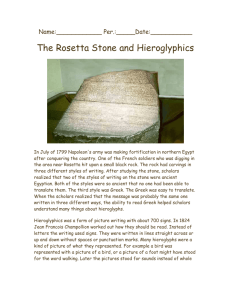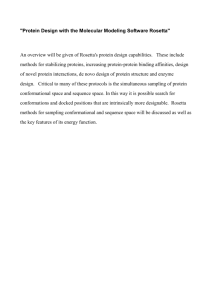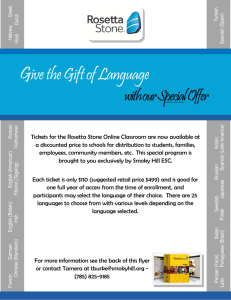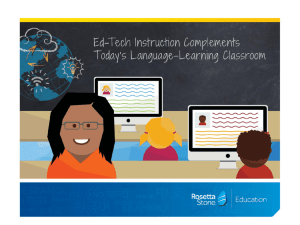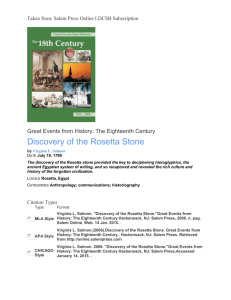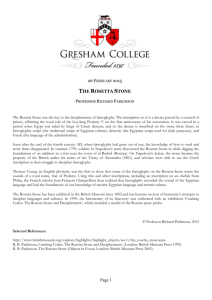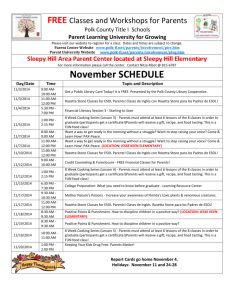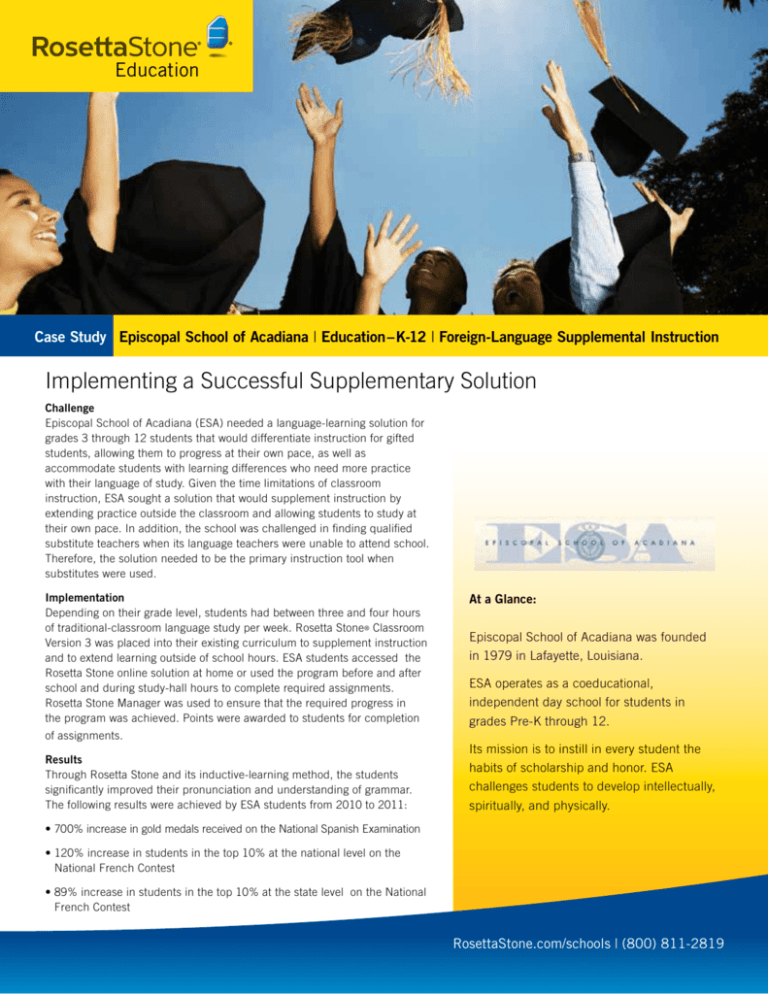
Education
Case Study Episcopal School of Acadiana | Education–K-12 | Foreign-Language Supplemental Instruction
Implementing a Successful Supplementary Solution
Challenge
Episcopal School of Acadiana (ESA) needed a language-learning solution for
grades 3 through 12 students that would differentiate instruction for gifted
students, allowing them to progress at their own pace, as well as
accommodate students with learning differences who need more practice
with their language of study. Given the time limitations of classroom
instruction, ESA sought a solution that would supplement instruction by
extending practice outside the classroom and allowing students to study at
their own pace. In addition, the school was challenged in finding qualified
substitute teachers when its language teachers were unable to attend school.
Therefore, the solution needed to be the primary instruction tool when
substitutes were used.
Implementation
Depending on their grade level, students had between three and four hours
of traditional-classroom language study per week. Rosetta Stone® Classroom
Version 3 was placed into their existing curriculum to supplement instruction
and to extend learning outside of school hours. ESA students accessed the
Rosetta Stone online solution at home or used the program before and after
school and during study-hall hours to complete required assignments.
Rosetta Stone Manager was used to ensure that the required progress in
the program was achieved. Points were awarded to students for completion
of assignments.
Results
Through Rosetta Stone and its inductive-learning method, the students
significantly improved their pronunciation and understanding of grammar.
The following results were achieved by ESA students from 2010 to 2011:
At a Glance:
Episcopal School of Acadiana was founded
in 1979 in Lafayette, Louisiana.
ESA operates as a coeducational,
independent day school for students in
grades Pre-K through 12.
Its mission is to instill in every student the
habits of scholarship and honor. ESA
challenges students to develop intellectually,
spiritually, and physically.
• 700% increase in gold medals received on the National Spanish Examination
•1
20% increase in students in the top 10% at the national level on the
National French Contest
•8
9% increase in students in the top 10% at the state level on the National
French Contest
RosettaStone.com/schools | (800) 811-2819
“With the combination of
Rosetta Stone and handson, small-group work, our
language teachers were
amazed by the improvement
in students’ pronunciation
and fluency levels.”
- Anita Huval
Department Chair
Episcopal School of Acadiana
World Language Program
Emphasizing immersion
Episcopal School of Acadiana’s language
program was founded on the belief of the
value of immersion within the classroom.
The school needed to differentiate
instruction for gifted students to allow an
increase in the level of challenge beyond
what the classroom environment could
deliver. In addition, some students needed
additional practice in their language of
study. Rosetta Stone® gave students the
flexibility to advance at their own pace and
supplement practice outside the classroom.
Enhancing classroom experience
Once the Rosetta Stone solution was
implemented, language teachers were able
to increase time spent on other creative
projects and activities. They were able to
take language learning to the next level by
integrating language activities into the
classroom. These included developing
fairy-tale videos or creating a digital slide
presentation for a three-day trip to Paris.
“With the combination of Rosetta Stone and
hands-on, small-group work, language
teachers were amazed at the improvement
in students’ pronunciation and overall
fluency levels,” stated Anita Huval,
department chair for the school’s World
Language Program.
Supporting staffing needs
Rosetta Stone also supported staffing
needs. In the past, finding qualified
substitute language teachers who could
actually speak the languages taught in the
classroom was difficult. As a result, classes
fell behind on curricula when teachers were
absent. With use of the program, students
had self-directed Rosetta Stone lessons,
and that meant less instructional time lost
in the classroom when teacher absence
occurred.
Experiencing results
The school saw improvement at every level
in both Spanish and French in student
achievement on national exams. It also
experienced the following growth rates in
performance on these exams from 2010
to 2011:
Spanish—Gold Medals Earned
700%
French — Top 10% National Level
each new grammar topic covered there was
at least one student in class who had
already learned about that topic in Rosetta
Stone. As a result, those students who
learned the grammar rules inductively prior
to class asked more complex questions and
supported their peers who were learning a
grammar lesson for the first time. This
created a more efficient instructional
process. Because students had inductive
exposure to grammar in Rosetta Stone, they
didn’t need as long of an explanation in the
classroom. This opened the door for higher
levels of learning and instruction.
120%
French—Top 10% State Level
89%
Scores on the National Spanish Examination
in 2010 resulted in students receiving 1
gold, 11 silver, and 11 bronze medals for a
total of 23 awards. In 2011, students
earned 8 gold, 5 silver, and 21 bronze
medals for a total of 34 awards.
There was significant improvement in
student results in the National French
Contest. In 2010, ESA had 18 students
place in the top 10% at the state level and 5
students in the top 10% nationally. In
2011, ESA had 34 students
in the top 10% at the state level and 11
students in the top 10% nationally.
Making the grade
Depending on the classroom, the grade
assigned to students for Rosetta Stone
usage was either a participation or
homework grade worth 20 to 25 points per
week. This had a significant impact on
overall averages. To earn their grades,
students in grades 3 through 6 accessed
Rosetta Stone from home. Computers were
also available before and after school for
their use.
In addition to home study, grades 7 through
12 had a study-hall period each day in
which they were allowed to do any
homework, including Rosetta Stone
assignments.
Expanding to peer-to-peer instruction
Rosetta Stone provided implicit, intuitive
grammar instruction to students. This was
an interesting complement to French and
Spanish curricula. Teachers saw that with
RosettaStone.com/schools | (800) 811-2819
About Rosetta Stone
Rosetta Stone is the global leader
in language-learning software. We
have over 20 years of experience
in developing award-winning
innovations that improve the
lives of people and operations of
organizations every day.
Our proprietary and proven
immersion method leverages
interactive technologies to replicate
the environment in which people
learn their first languages and
activates learners’ natural aptitudes
for learning a new language
regardless of their language
backgrounds.
We offer our clients scalable
solutions for a variety of needs, from
single classrooms to entire
organizations and individual
learners. Our solutions are
implemented in over 15,000
schools, in more than 10,000
private and public sector
organizations, and are used by
millions of learners in over 150
countries throughout the world.
Education
©2011 Rosetta Stone Ltd. All rights reserved. SLK-EDU-ESA-1109

